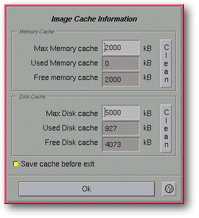

The Image Cache configuration dialog box allows for immediate view of the image cache and
permits changes to be made to its specifications. The image cache is a memory stamp which
will store in active memory or on disk the images used in documents opened by XMayday.
Images are first placed in the active memory cache, then once that is full the system
stores less frequently-used pictures in the cache on disk. The initial specifications of
this image cache are defined in the configuration files.

Screen shot: Image cache configuration dialog box.
Upper portion of the dialog box:
- The "Memory Cache" section deals with the
ensemble of images contained in the active memory portion of the image cache.
- Total "Max Memory Cache" defines the
maximum size of the image cache in memory. This value is expressed in kilo-bytes (1024
bytes) and must be set between 0(Kb) and 100,000(Kb). Changes to the Total Memory Cache
take effect immediately. If the value 0 (Kb) is specified, the image cache has only enough
memory to hold the last image loaded.
- The "Used Memory Cache" information
text field indicates the current amount of space occupied by the images in the memory
cache. This non-modifiable value can be greater than the maximum total memory size of
the image cache by the size of the last image loaded.
- The "Free Memory Cache" information
text field indicates the amount of memory space still available in the images
cache. This value is determined by subtracting used memory cache from Total memory cache.
Because the used memory can be larger than the total size, this value can be negative.
- The "Clean" button empties the Memory
Cache. It destroys images currently held in memory, meaning they will require
re-loading upon next use (ex. for rotation or sizing). In order to free up memory and
space, it's a good idea to empty the memory cache when modifying a image file that will be
reloaded from XMayday.
- The "Disk Cache" section deals with the
ensemble of images contained in the image cache stored on the hard disk.
- The "Max Disk cache" text field defines
the maximum size of the image cache on the hard disk. This value is expressed in
kilo-bytes (1024 bytes) and must be set between 0(Kb) and 1,000,000(Kb). Changes made to
this value take effect immediately. If a value of 0(Kb) is specified, the image cache
cannot hold anything in memory on the hard disk; the images will be reloaded from their
original file upon their next use (ex. for rotation or sizing).
- The "Used Disk Cache" information text
field indicates the amount of disk space currently occupied by images. This value
cannot be modified.
- The "Free Disk cache" information text
field indicates the available free disk space in the image cache. This value is
calculated by subtracting the Used Disk Cache from the Total Disk Cache.
- The "Clean" button empties the disk
cache. It deletes images currently stored on the disk, meaning they will require
re-loading upon next use (ex. for rotation and sizing). In order to free up disk space,
it's a good idea to empty the disk image cache when modifying an image file to be reloaded
from XMayday.
- The "Save Cache before quitting" button saves
the contents of XMayday's active memory and disk caches until their next use. If this
button is not engaged, the disk cache will be deleted when quitting XMayday in order to
free up space on the hard disk. It's a good idea to activate this button when frequently
editing the same XMayday document.
Note: When changing display type on a server (for ex., altering display depth)
between two launchings of XMayday, it's preferable to empty the cache before loading image
contained within.
Lower portion of the dialog box:

![]()
![]()

![]()